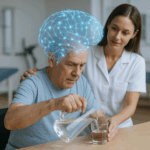Physiotherapy Treatment Protocol for Acute Onset of Mechanical Shoulder Pain
Overview of Conditions:
Mechanical shoulder pain refers to pain originating from the musculoskeletal structures of the shoulder, including muscles, tendons, ligaments, and joints. Acute mechanical shoulder pain typically arises from trauma, overuse, sudden movements, or poor posture. Common conditions associated with acute mechanical shoulder pain include rotator cuff injuries, shoulder impingement, and muscle strains. The pain is often characterized by sudden onset, localized tenderness, restricted range of motion (ROM), and pain during specific movements, especially overhead tasks or lifting.
Etiology:
Acute shoulder pain can result from repetitive overhead activities (e.g., sports, heavy lifting), falls or direct trauma (e.g., shoulder dislocations or fractures), or sudden jerking motions that overstretch or tear muscles or tendons around the shoulder joint (Cools et al., 2021).
Assessment and Evaluation:
- History:
- Onset of Pain: Inquire about the nature of the injury (e.g., sudden, gradual onset, or following specific activities such as lifting or a fall).
- Pain Characteristics: Characterize the pain as sharp, dull, or aching, and determine if it radiates.
- Aggravating Factors: Pain during overhead movements, lifting, or reaching behind the back suggests rotator cuff involvement or impingement.
- Relieving Factors: Rest, ice, and avoiding certain movements may provide relief.
- Pain Assessment:
- Visual Analog Scale (VAS): To assess pain severity.
- Disability of the Arm, Shoulder, and Hand (DASH) Score: To evaluate the functional impact of the injury on daily activities.
- Physical Examination:
- Postural Assessment: Look for any postural abnormalities (e.g., rounded shoulders, forward head posture) that could be contributing to mechanical stress.
- Inspection: Check for visible swelling, bruising, or deformity.
- Palpation: Palpate the acromioclavicular (AC) joint, rotator cuff, and biceps tendon to identify tenderness.
- Range of Motion (ROM): Assess both active and passive ROM, particularly flexion, abduction, and external rotation. Pain and restricted ROM may suggest muscle strain, tendonitis, or impingement.
- Strength Testing: Test the strength of the rotator cuff muscles (supraspinatus, infraspinatus, subscapularis).
- Special Tests: Perform tests like Neer’s Test and Hawkins-Kennedy Test for impingement, Empty Can Test for supraspinatus tendonopathy, and Drop Arm Test for rotator cuff tear.
Goal Setting:
- Short-Term Goals:
- Reduce pain and inflammation.
- Improve ROM and prevent further restriction.
- Alleviate muscle spasms and tension in the shoulder girdle.
- Educate the patient on posture and movement modifications to avoid exacerbation.
- Long-Term Goals:
- Restore full ROM and strength.
- Improve shoulder function for daily activities and return to sports or work.
- Prevent recurrence through postural correction, strengthening exercises, and ergonomic adjustments.
- Educate on self-management strategies, including stretching, strengthening, and proper posture.
Recommended Treatment:
Electrotherapy:
- Transcutaneous Electrical Nerve Stimulation (TENS):
- Indication: Pain and muscle spasms in the acute phase.
- Parameters:
- Frequency: 80-120 Hz
- Intensity: Comfortable, sub-threshold to strong stimulation.
- Pulse width: 100-300 µs.
- Duration: 20-30 minutes, 2-3 times per day.
- Mechanism: Modulates pain perception by stimulating sensory nerves and reducing muscle spasms.
- Interferential Therapy (IFT):
- Indication: Reduces pain and promotes tissue healing in deeper shoulder structures.
- Parameters:
- Frequency: 4,000 Hz carrier frequency, modulated at 80-150 Hz for muscle spasm relief.
- Duration: 20-30 minutes.
- Mechanism: Stimulates deeper tissues, promotes muscle relaxation, and enhances circulation.
- Class 4 LASER Therapy:
- Indication: Reduces pain, inflammation, and promotes tissue repair.
- Parameters:
- Wavelength: 800-900 nm.
- Power: 5-10 W.
- Duration: 5-8 minutes per treatment area.
- Mechanism: Stimulates cellular regeneration, enhances blood flow, and accelerates tissue healing.
- Ultrasound Therapy:
- Indication: Reduces inflammation and promotes soft tissue healing.
- Parameters:
- Frequency: 1 MHz (for deeper penetration).
- Intensity: 0.5-1.0 W/cm².
- Duration: 5-10 minutes per area.
- Mechanism: Increases tissue temperature, reduces inflammation, and promotes healing through mechanical vibration.
Thermotherapy:
- Moist Heat Packs:
- Indication: Reduces pain and muscle spasms (after initial inflammation subsides).
- Application: Apply moist heat packs for 15-20 minutes.
- Mechanism: Heat increases blood flow, promotes muscle relaxation, and alleviates pain and stiffness.
Manual Therapy:
- Myofascial Release:
- Indication: Alleviates muscle tightness and trigger points in the shoulder girdle.
- Technique: Apply gentle, sustained pressure to the affected muscles, particularly the rotator cuff and upper trapezius.
- Mechanism: Improves circulation and reduces muscle spasms and tightness.
- Muscle Energy Techniques (MET):
- Indication: Improves shoulder flexibility and reduces muscle tension.
- Technique: Perform isometric contractions followed by passive stretches to the affected muscles (e.g., rotator cuff).
- Mechanism: Improves muscle length and decreases muscle tone through autogenic inhibition.
Exercise Therapy:
- Range of Motion (ROM) Exercises:
- Exercise: Gentle, pain-free active and passive shoulder ROM exercises like pendulum swings and wall climbing.
- Duration: 5-10 repetitions, 3-4 times per day.
- Mechanism: Reduces stiffness and maintains shoulder joint mobility.
- Strengthening Exercises (Gradual progression after pain reduction):
- Exercise: Isometric exercises for rotator cuff muscles and scapular stabilizers.
- Reps: 10-15 repetitions, 2-3 sets per day.
- Mechanism: Strengthening the rotator cuff and scapular stabilizers improves shoulder stability and function.
- Postural Training:
- Exercise: Scapular retraction and chin tuck exercises.
- Mechanism: Correcting posture reduces strain on the shoulder and improves alignment.
Precautions:
- Electrotherapy:
- Avoid TENS or IFT in patients with pacemakers or implanted electronic devices.
- Exercise caution when applying electrotherapy over open wounds or damaged skin.
- Thermotherapy:
- Avoid applying heat during the acute inflammatory phase (first 48-72 hours).
- Monitor skin integrity to prevent burns or discomfort.
- Manual Therapy:
- Apply myofascial release and MET techniques gently during the acute phase to avoid exacerbating pain.
- Be cautious with joint mobilizations or manipulations in patients with recent trauma or instability.
- Exercise Therapy:
- Ensure exercises are performed without pain, gradually increasing intensity as tolerated.
- Avoid overhead movements or heavy lifting until pain subsides.
Reassessment and Criteria for Progression/Change in Care Plan:
- Pain Reduction:
- After 1-2 weeks, pain should significantly decrease (VAS ≤ 3). If pain persists, adjust the treatment plan.
- Range of Motion (ROM):
- Within 2-3 weeks, aim for 80-90% of normal shoulder ROM. If there is limited progress, modify treatment modalities or incorporate more aggressive techniques.
- Strength and Function:
- After 4 weeks, reassess strength, especially of the rotator cuff and scapular stabilizers. Gradual improvement in strength should be expected with appropriate exercises.
- Discharge Criteria: Consider discharge once pain is minimal (VAS ≤ 2), full functional ROM is restored, and strength is 80-90% of normal. Educate the patient on home exercises and posture correction to prevent recurrence.
References:
- Cools, A. M., et al. (2021). “Rehabilitation of shoulder impingement syndrome: A comprehensive approach.” Sports Medicine, 51(10), 1649-1663. https://doi.org/10.1007/s40279-021-01450-7
- Ray, D., et al. (2021). “Therapeutic modalities for shoulder pain: A systematic review.” Journal of Pain Research, 14, 925-940. https://doi.org/10.2147/JPR.S306698
- Lu, Z., et al. (2020). “Effectiveness of electrotherapy in treating shoulder pain: A systematic review.” Journal of Clinical Physiotherapy, 31(4), 223-230. https://doi.org/10.1056/JCP-S00172
Disclaimer and Note:
Treatment options must be chosen wisely and appropriately. For example, where multiple options are recommended, any one option can be selected based on availability and appropriateness, such as in electrotherapy. The recommendations in this protocol should be customized to each individual’s condition and response to treatment. Always consult a healthcare professional for diagnosis and treatment.
This content is for informational purposes only and is not intended as medical advice. Always consult a qualified healthcare provider before starting any treatment.






